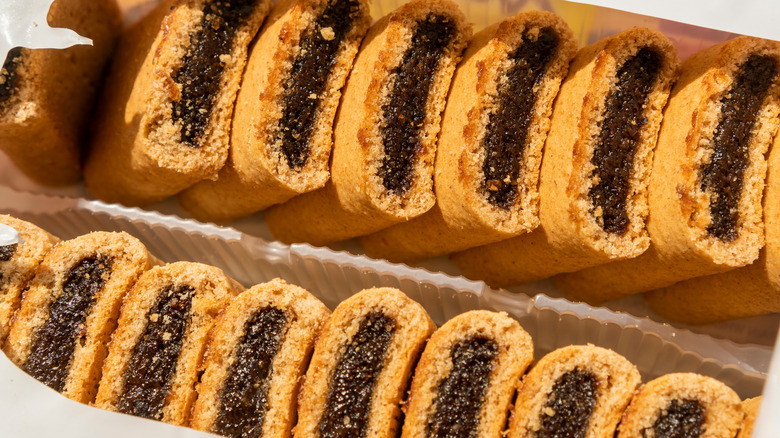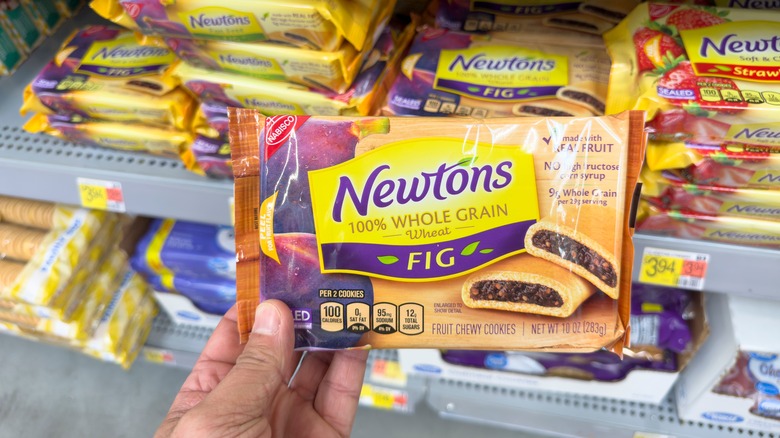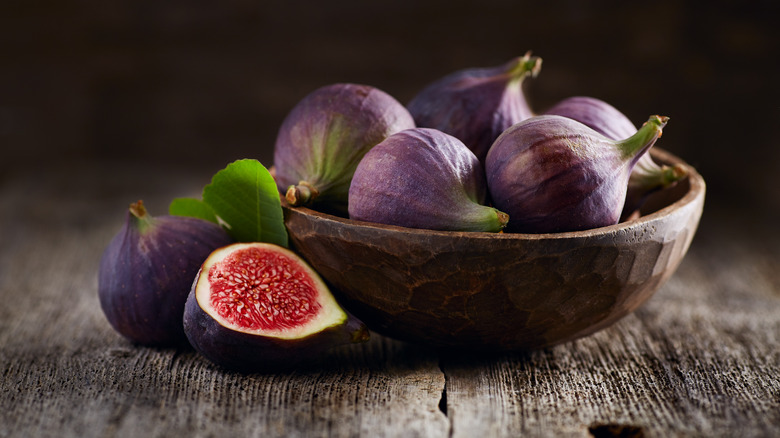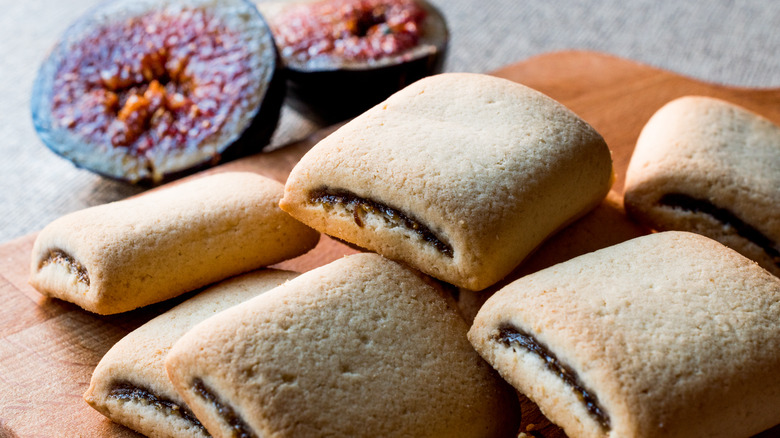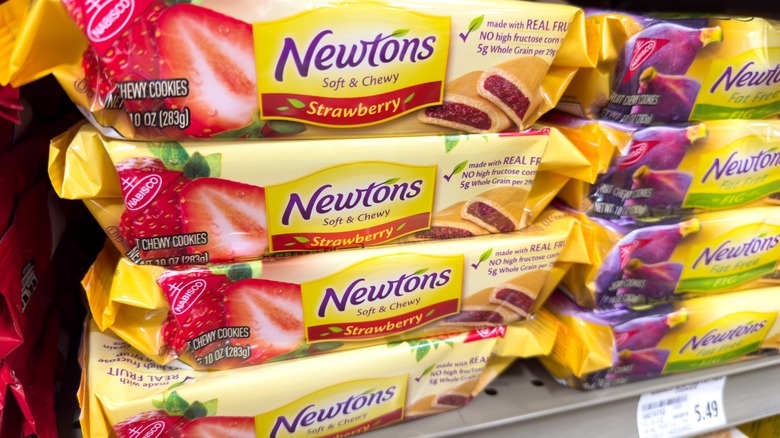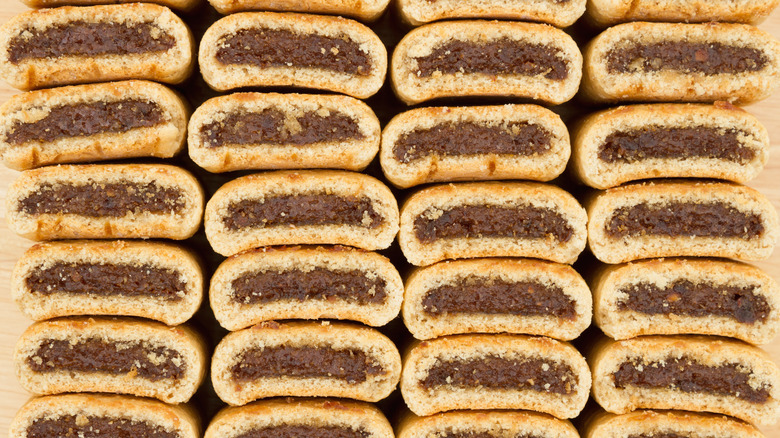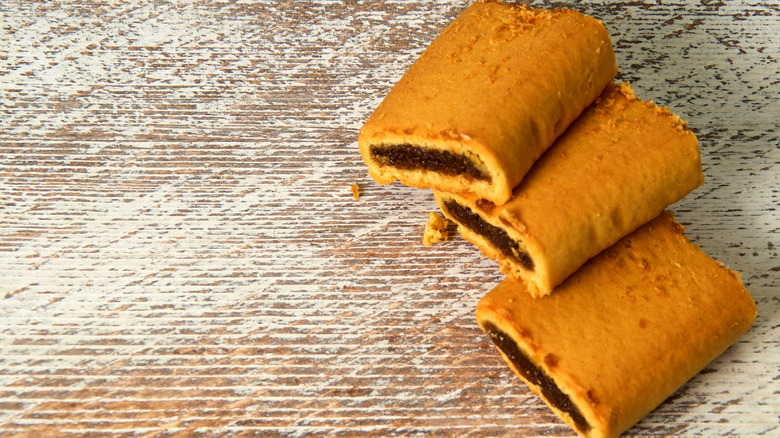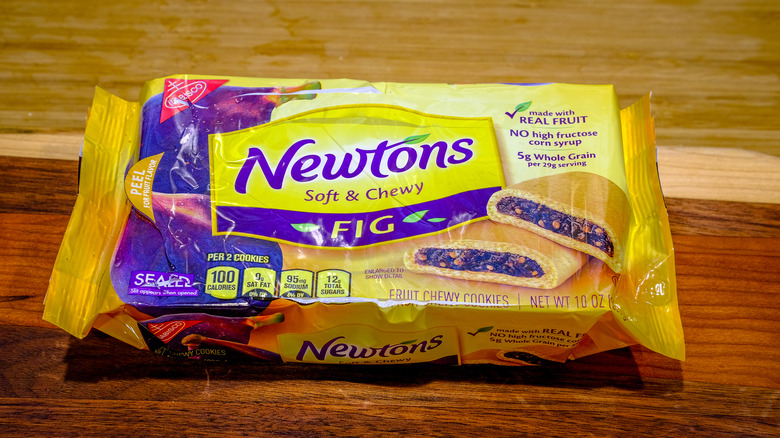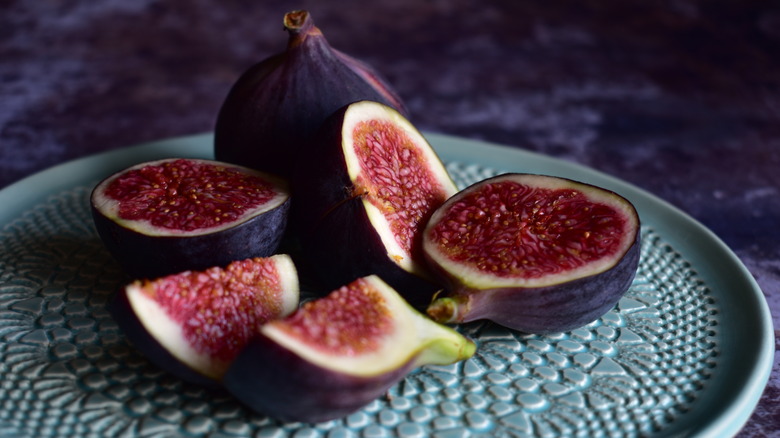10 False Facts About Fig Newtons You Probably Thought Were True
If you've ever wanted an example of how a food product can defy logic, we present to you the humble Fig Newton. On paper, these cookies are total outliers in today's multicolored, sugary snack world. A simple, somewhat old-fashioned combination of fig paste piped into a soft whole grain shell, they're hardly as exciting as some other offerings out there. However, Fig Newtons have stood the test of time with a lengthy history spanning well over 100 years, and today they remain one of the most popular cookies out there.
As with any food product that's been around for a while, Fig Newtons have had a lot said about them — and not all of it is true. There are so many false facts out there about these unassuming cookies that it's hard to know where to start with debunking them. The origins of the snack's very name, which many people think comes from a rather famous physicist (three guesses as to who that is!), its ingredients, and its healthiness have all been misrepresented time and time again. That's why we've rolled up our sleeves to separate fact from fiction, and to let you in on the truth about Fig Newtons.
False: Fig Newtons are named after Isaac Newton
What do you picture when you think of the word "Newton?" An apple falling on someone's head, perhaps? You're not alone — the name is so well associated with physicist Isaac Newton that somewhere down the line, people started to assume that Fig Newtons were named after him. That isn't quite the case. The real origin of the "Newton" in Fig Newton comes from Newton, Massachusetts, the town that the cookies were really named after. The Kennedy Biscuit Works, the Massachusetts-based business that pioneered Fig Newtons, had a longstanding tradition of naming their products after communities in the state. They picked Newton for this specific cookie, and a timeless brand was born.
So, where does the Isaac Newton rumor come from? Well, one story goes that James Henry Mitchell, the inventor of the funnel machine that fills Fig Newtons with their paste, was so proud of his ingenious creation that he thought the cookies worthy of Isaac's name. We can definitely see why he could have come to that conclusion — the technology must have been pretty incredible in the late 1800s. The truth, though, is far simpler and less boastful.
False: Fig Newtons have always been a cookie
Fig Newtons are cookies, right? We definitely think so — but if you lived a few decades ago, you may not have felt the same. Fig Newtons haven't always been known as a cookie, and were instead branded as a "cake" by Nabisco, all the way up until the 1980s. One lighthearted commercial from this decade sought to poke fun at the confusion between the two, featuring a courtroom scenario which established them not as cookies, but as "fruit and cake."
We can understand why Nabisco was taking this approach. After all, Fig Newtons are way softer than you'd expect from a classic cookie, and have a cake-like consistency. There's also something slightly classier and luxurious about calling them cakes, which perhaps ties into their image as a more mature, elegant snack. This is all despite the fact that they've been found in the cookie aisle for as long as we can remember, of course — and during the 1980s, Nabisco decided to rethink things. The branding for Fig Newtons was quietly changed, and they started to be referred to as "chewy cookies."
False: Fig Newtons have bits of wasp in them
One of the most pervasive false facts about Fig Newtons is also one that affects the very fruit they contain. There's a longstanding myth that figs, and by extension Fig Newtons, have bits of wasp sitting inside the fruit. Although this sounds too wild to be even considered as true, it's actually based in reality. Figs can be male and female, and the female figs require pollination from wasps. When a female wasp crawls into a male fig, it lays eggs and the hatchlings crawl out and carry away pollen. In a female fig though, the wasp can't lay any eggs, and instead dies inside the fig.
So... figs contain dead wasps? Not quite. The part that everyone forgets to mention is that female figs release enzymes that then break the wasp's body down, completely dissolving it. By the time the fig makes it to the factory to be processed into paste for the cookie, there's no trace of wasp whatsoever. We'll admit that knowing that a wasp died inside the figs that go into your Fig Newtons may put some people off, but at least you don't have to worry about munching through pieces of wasp wing.
False: Fig Newtons are way healthier for you than other snacks
Okay, so we can kind of understand this one. It's easy to see why a lot of people think that Fig Newtons are healthy cookies, considering their main ingredients. Composed primarily of fig jam and whole grains, they give the impression of being more nutritious and somehow more processed than the sugary, chocolate chip-infused cookies they're often stacked next to.
However, that's not quite the case. Over on Mashed, registered dietitian and nutrition therapist Emily Van Eck and clinical assistant professor of nutrition and dietetics Natalie Allen took part in a deep dive into Fig Newtons' ingredients. While there were some positives to be found, the fact remains that the cookies are still a processed food, and are surprisingly high in both sugar and sodium. As such, they may not be the worst option out there — but they're comparable with other convenient snacks that don't put their nutritional value front and center.
Having said this, both Van Eck and Allen point out that you shouldn't be afraid of eating them. "If you like Fig Newtons, they can be [a] healthy part of a balanced diet and would make an easy and convenient snack, especially for on the go," says Van Eck. Just don't eat too many in one go, and try to eat some protein and healthy fats with them, by pairing them with a nut or seed butter.
False: Fig Newtons are called Fig Newtons
Are you ready to have your mind blown, folks? Here we go: Those Fig Newtons you're munching on aren't actually called Fig Newtons, and haven't been for a while. In fact, Nabisco dropped the "Fig" from "Fig Newtons" way back in 2012, with the product now known as just "Newtons." The main thrust behind this move was to try and make more visible space for other flavors in the Newtons line, and to shift away from the somewhat old-fashioned appearance of a fig-flavored cookie. "To a lot of people a fig means 'geriatric' and that's not good," explained the Integrated Marketing Group's co-founder Jeff Hilton via the New York Times. Unfortunately, the brand had started to become unappealing to younger audiences, and things had to change.
That's not to say that you can't still find fig-flavored Newtons, of course — they're still the brand's flagship product. However, you'll find these right next to Strawberry Newtons, an alternative flavor that has a slightly more universal feel to it (and which was, interestingly, around way before 2012).
False: Fig Newtons are an old-fashioned, unpopular snack
Fig Newtons are one of those foods that feel like they're from another time. We can definitely understand why: Fig flavors aren't exactly appealing to younger consumers, and you're probably far more likely to find them in the kitchens of people with mature tastes. However, that doesn't mean that they're on the decline. On the contrary, Fig Newtons remain one of the most popular cookies out there, with the Times Record reporting that over a billion are sold each year in the United States.
Importantly, it's unclear as to whether these sales only cover the fig-flavored version of the cookie, or whether they encompass other flavors too. However, given that Fig Newtons are far and away the most prominent product in the Newton line, it's fair to assume that they make up a hefty proportion of these sales. Hey, if something's been around since the late 1800s and is still in virtually every store, it has to be doing something right, y'know?
False: Fig Newtons are great for constipation
One of the biggest false facts out there about Fig Newtons relates to your digestive system. There's a longstanding myth that these cookies are somehow good for constipation, and can make your trip to the toilet a little easier. On the surface, this rumor makes sense. Fig Newtons promote figs as their main ingredient, which are known as a constipation cure thanks to being high in fiber. The cookie is also made of whole grains, which are also considered a great source of fiber, and the two combined may point towards an easier passage, as it were.
However, a closer inspection of the Fig Newtons nutritional label debunks this myth. Each serving of Fig Newtons, which amounts to two cookies, provides two grams of fiber. This isn't a bad amount when it comes to cookies, but it isn't really enough to get things moving. By comparison, one medium fig contains roughly 1½ grams of fiber, and the dried version (which are more known for aiding constipation) has around 10 grams in a recommended 100 gram serving. The latter amount is way more likely to help out. But the cookies? Not so much.
Fig Newtons' association with helping constipation has also been somewhat of a headache for Nabisco's marketing team. Part of the drive to change the Fig Newtons name to Newtons in 2012 was because of the fruit's association with helping gut mobility which, like prunes, projects a somewhat elderly, medicinal image.
False: Fig Newtons are the state cookie of Massachusetts
Fig Newtons' relationship with Massachusetts runs deep. The cookies are named after Newton, Massachusetts, and were first pioneered by The Kennedy Biscuit Works, which was based in the Northeastern state. Because of this historic association, many people assume that Fig Newtons are the state cookie of Massachusetts — but they'd be wrong.
In 1997, the state was deciding which baked good would get the official honor of being Massachusetts' state cookie, with then-governor William Weld backing the Fig Newton. "Everybody I knew grew up with Fig Newtons. The packaging is distinct, they're delicious," Weld said to The Associated Press (via South Coast Today). "I think out of respect for (the late Newton Mayor) Teddy Mann, that alone should lead us to cast our lot with the Fig Newton."
Unfortunately, Weld didn't get his wish, as there was a cookie that was even more famous that was also invented in the state. The chocolate chip cookie, created in the 1930s by Ruth Wakefield in Whitman, Massachusetts, gained the illustrious honor. Look, we love Fig Newtons, but we've gotta say it: If we have the option of chocolate chip cookies in that race, we'd pick it too.
False: Fig Newtons were invented by Nabisco
Fig Newtons are so closely tied to the Nabisco brand name that it's easy to assume that they invented the iconic cookie. However, that's not quite the case. The invention of the Fig Newton can instead be attributed to a man named Charles Roser. Roser was an Ohio-born cookie maker and real estate developer (quite a combo of professions, right?), who developed the recipe for Fig Newtons. This recipe caught the eye of the Kennedy Biscuit Works, who subsequently bought the recipe from Roser, and started mass-producing Fig Newtons in 1891.
They did this with the help of an invention from a different man, James Henry Mitchell. Mitchell created a machine that had a double-funnel technology. The outside funnel would pipe cookie dough out, while the inside funnel filled the dough with fruit paste. The machine operators would end up with one long Fig Newton, which they could then slice into smaller cookies (though rest assured, if you don't have your own funnel machine, you can still make Fig Newtons at home). While these two men are responsible for the Fig Newton's creation, the Kennedy Biscuit Works is arguably responsible for its wide scale success. Pretty soon, Kennedy Biscuits was renamed Nabisco, and the rest is history.
False: Fig Newtons have fruit in them
So, we can agree to disagree on this one, but we've got science on our side. It sounds pretty wild to claim that Fig Newtons don't have fruit in them when their main component is figs. How much you believe this, however, depends entirely on what you classify figs as — and if we're being really strict about it, they're not fruit at all. So what are figs if not fruit? Botanically speaking, they're actually inflorescences, a concentrated collection of flowers and seeds enclosed by a thick skin. It's this flowery quality that requires them to be pollinated by wasps in such a unique fashion, by literally crawling inside them.
It's also what gives them their unique, lumpy interior texture, which sets them apart from other fruits, which generally have a smooth, consistent flesh. No matter how you square it, though, figs are delicious. While they may not technically be fruit, they certainly taste like it. As such, it's a bit long winded to explain to people every time they're eating Fig Newtons that they're munching on flowers instead. You can be smug in your knowledge, though.
Static Media owns and operates The Daily Meal and Mashed.
